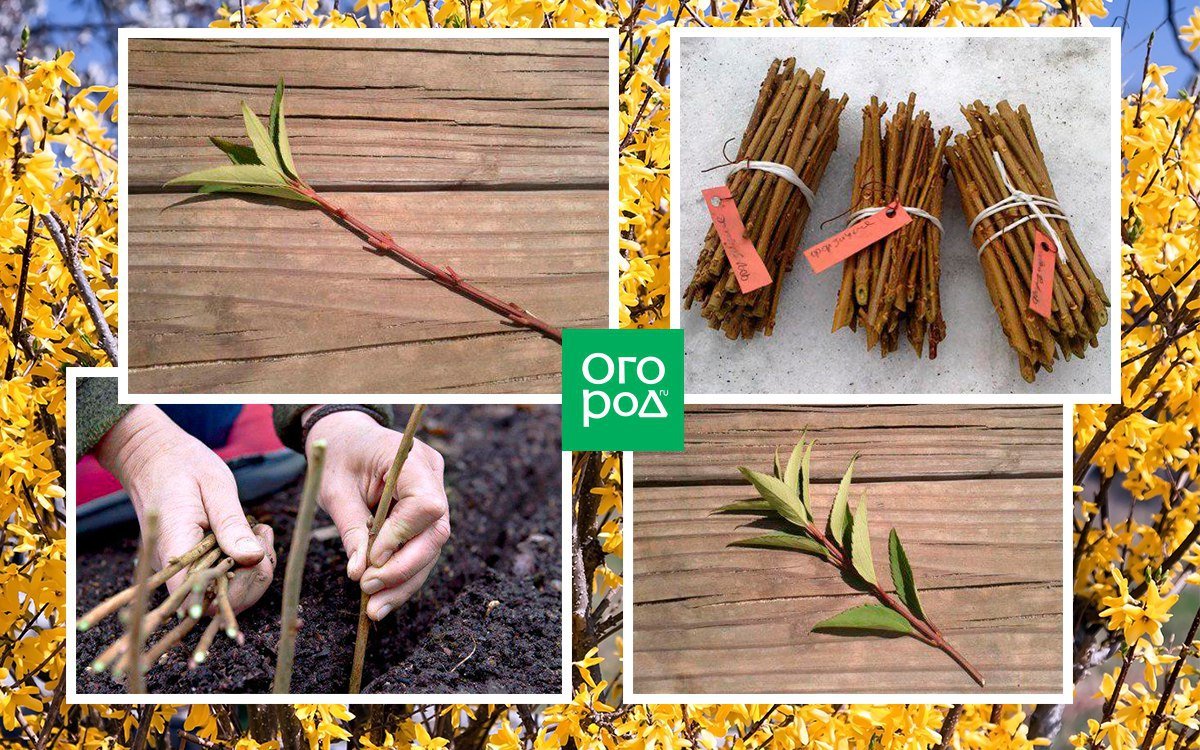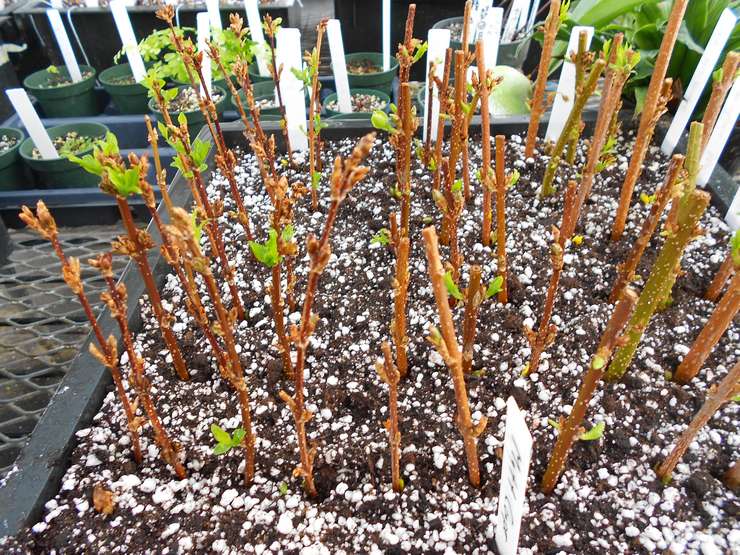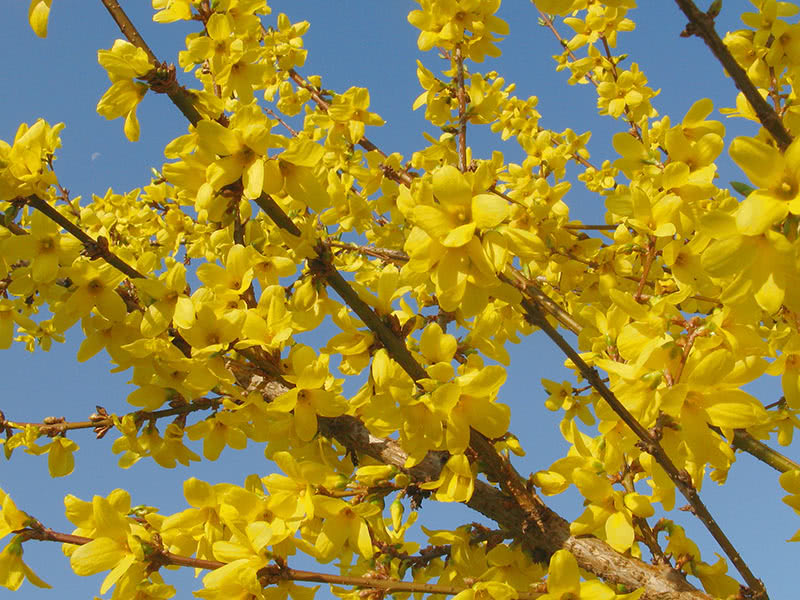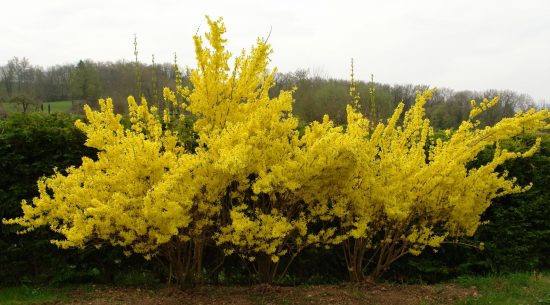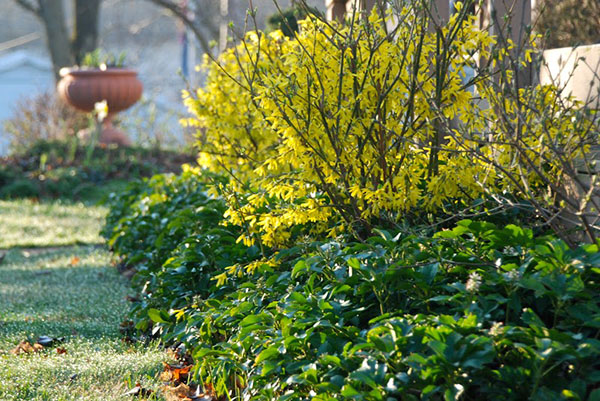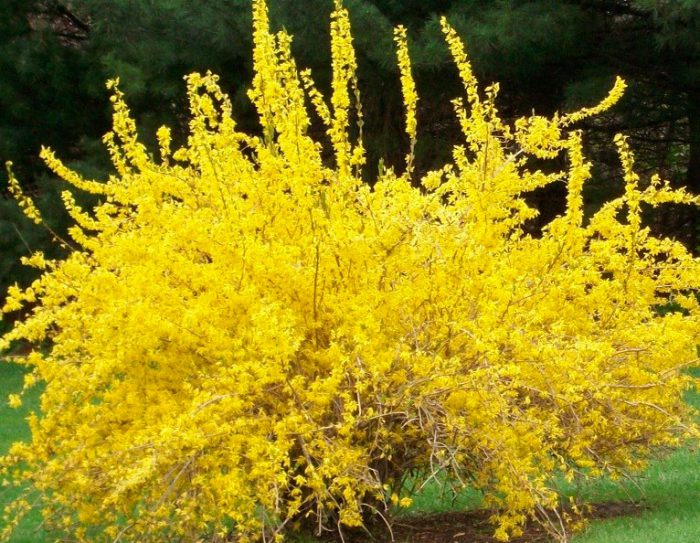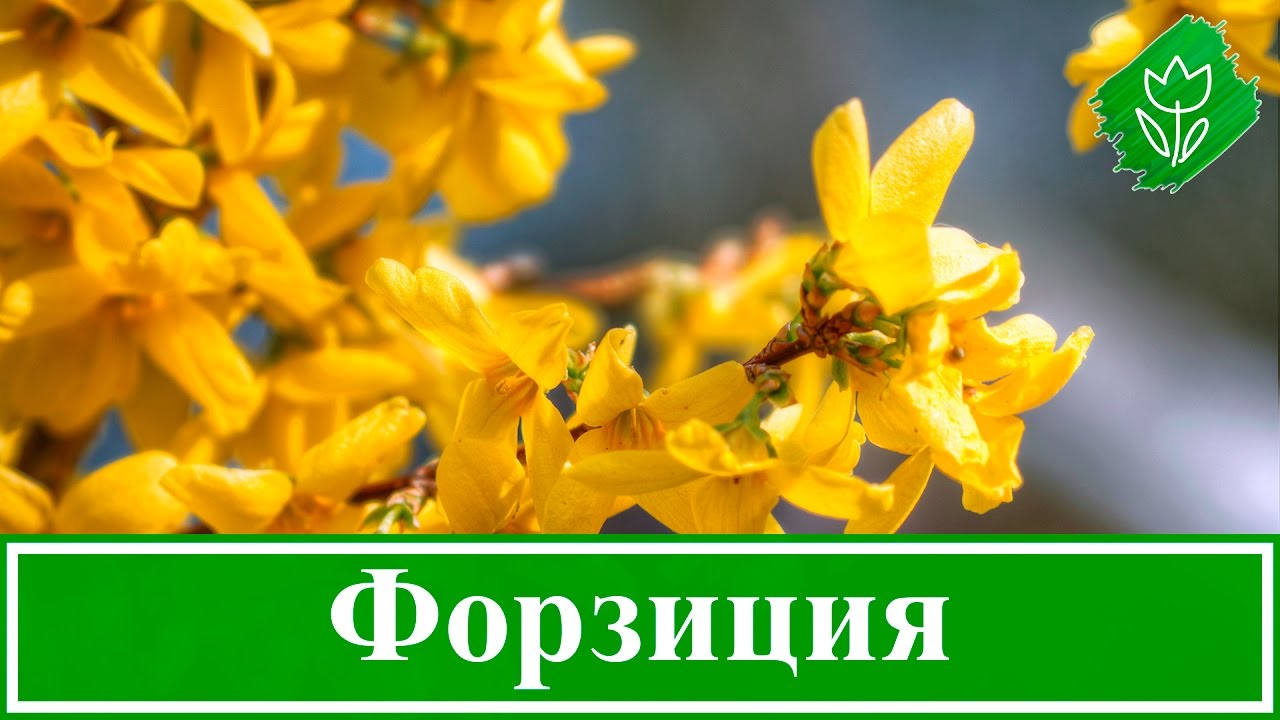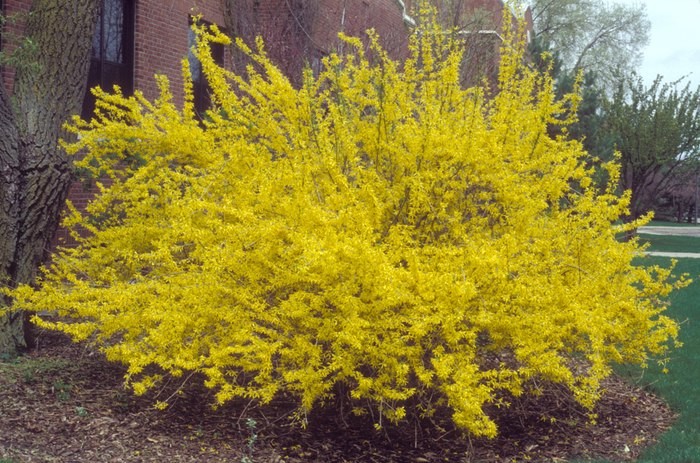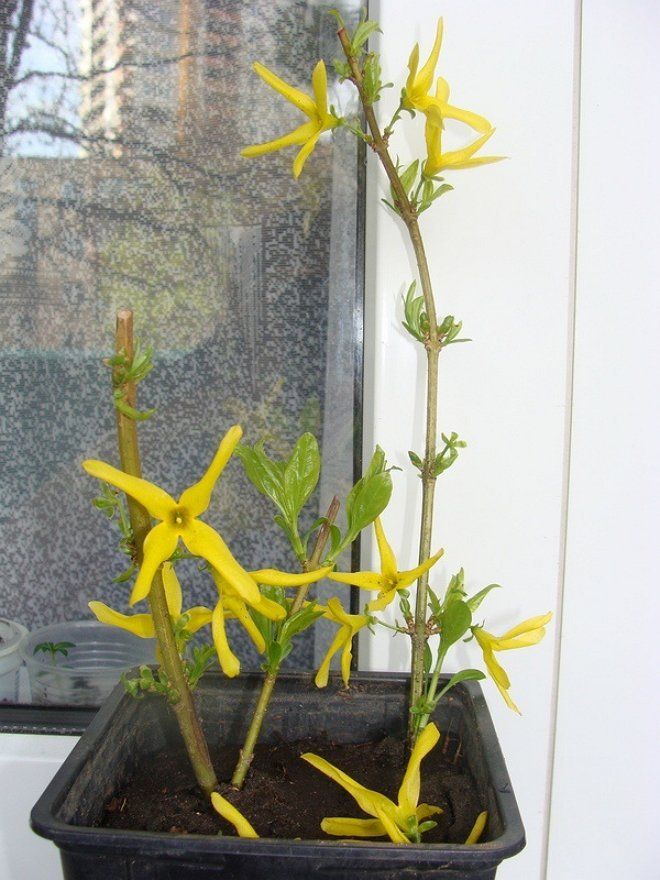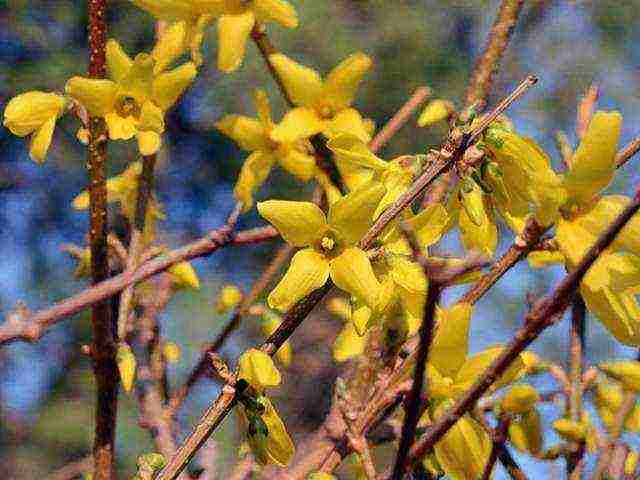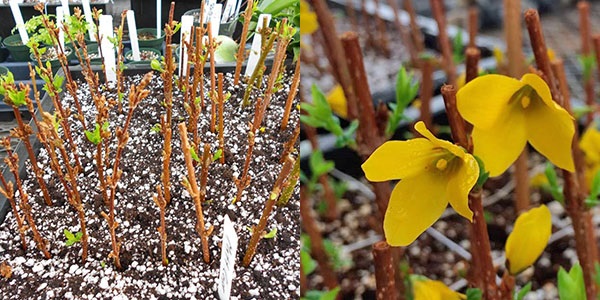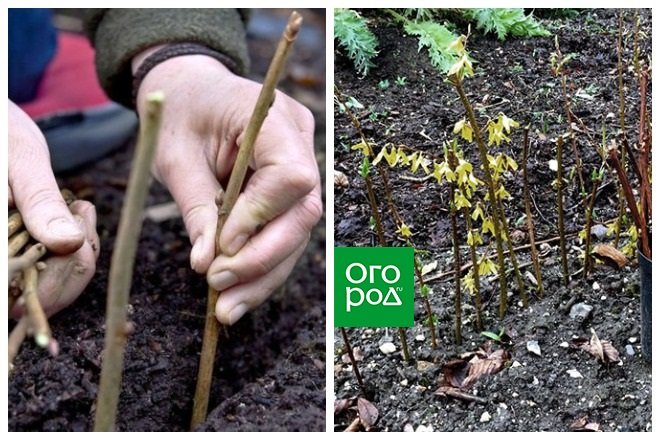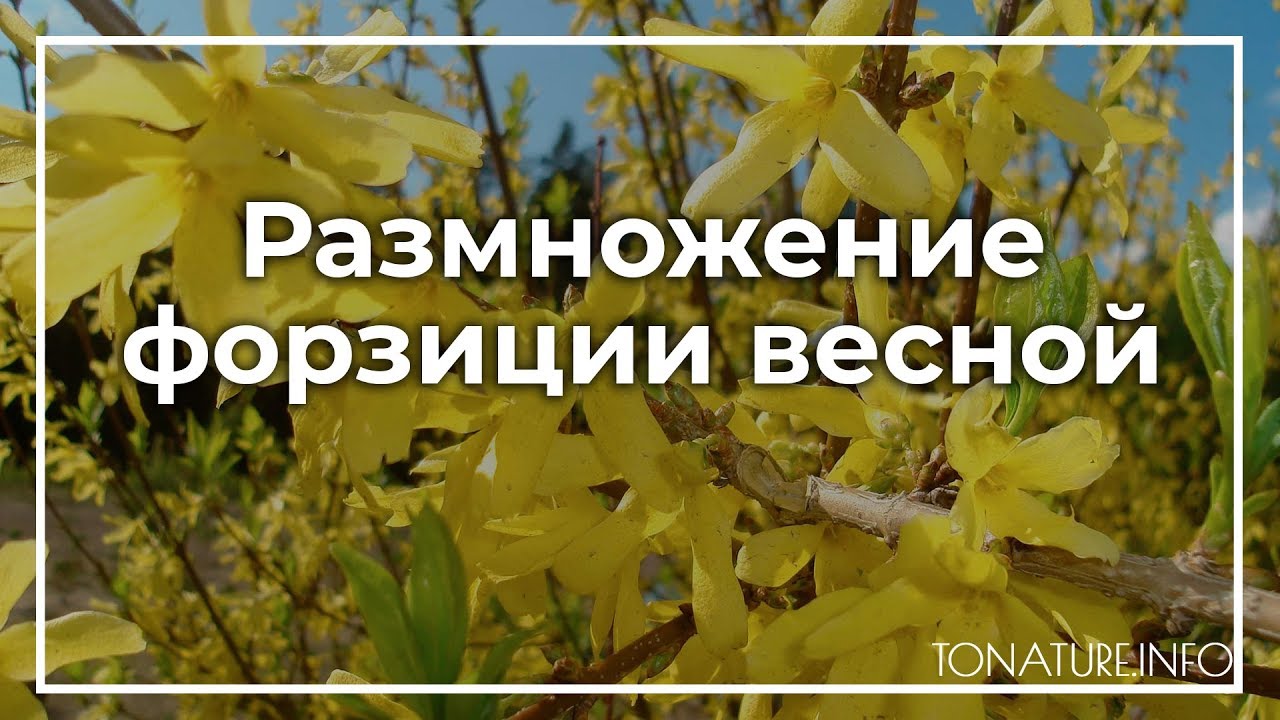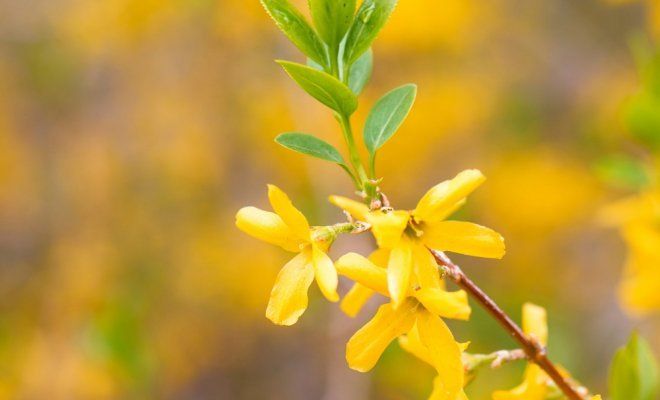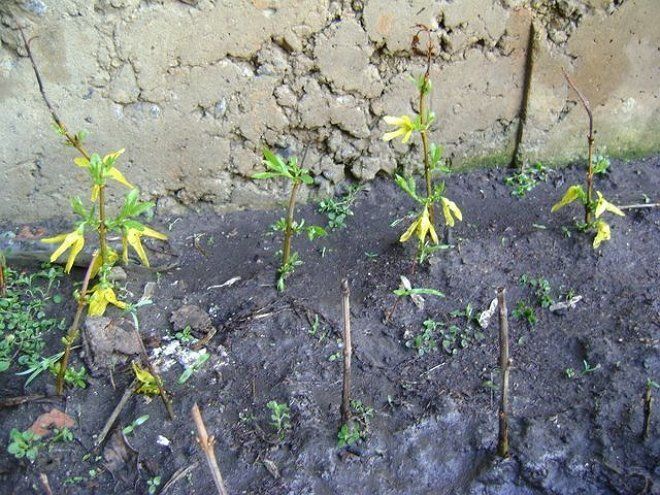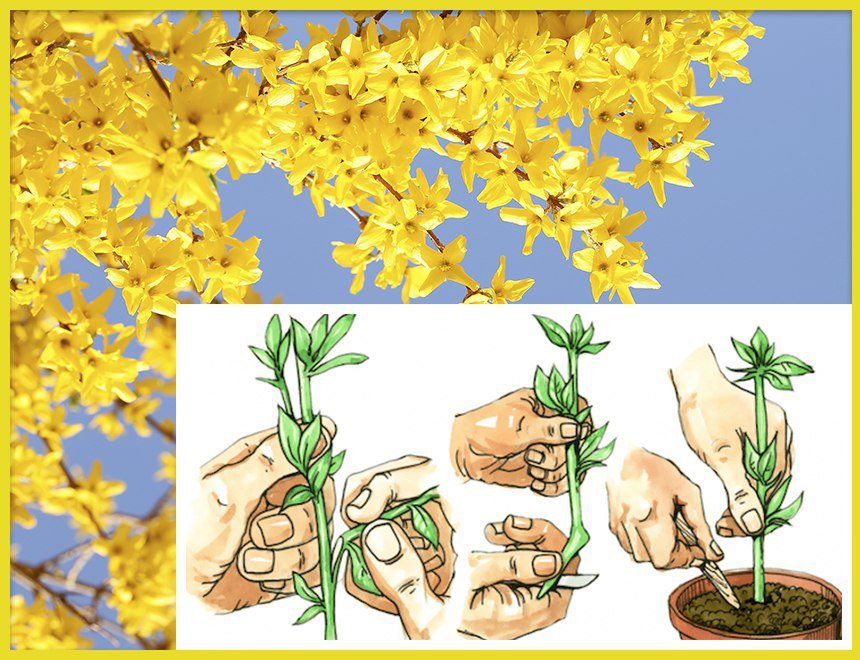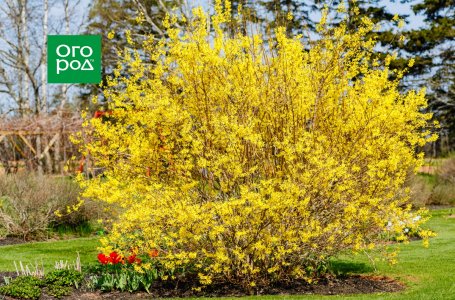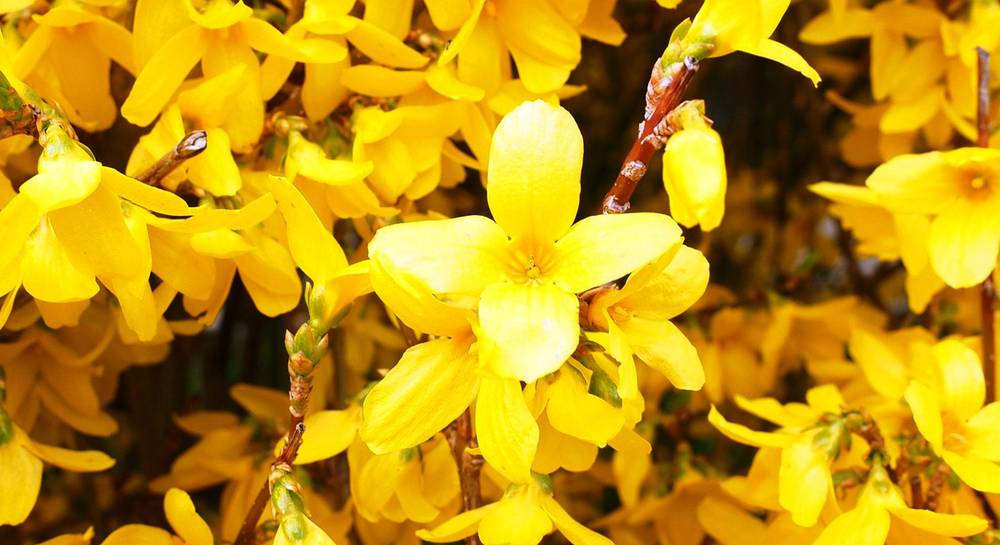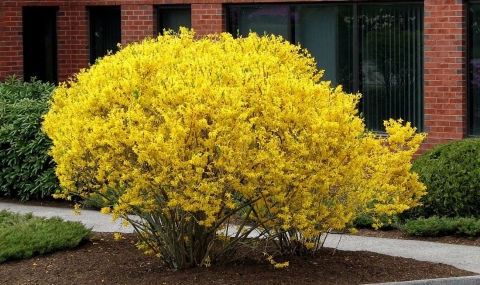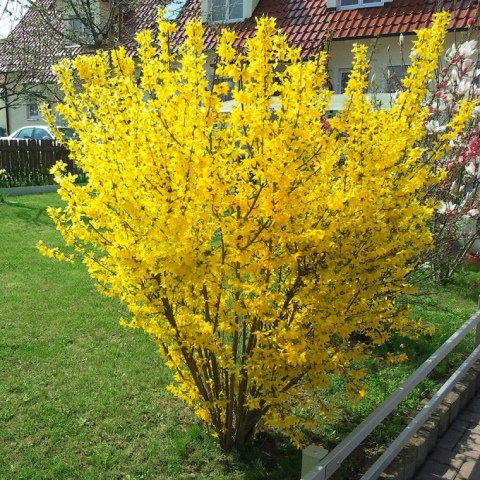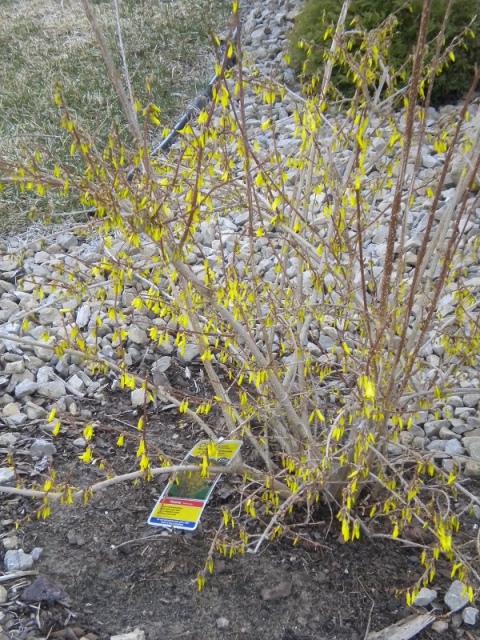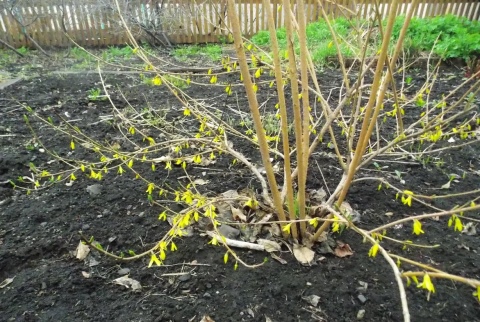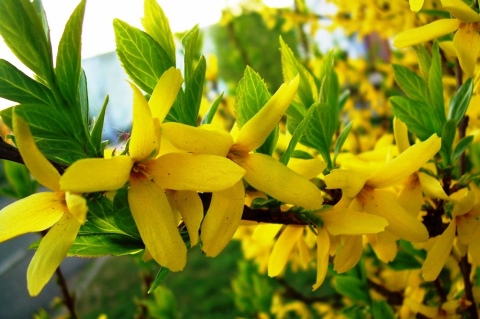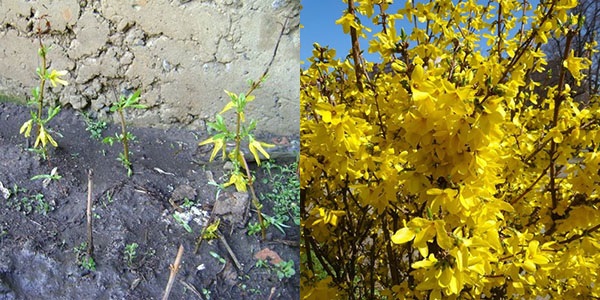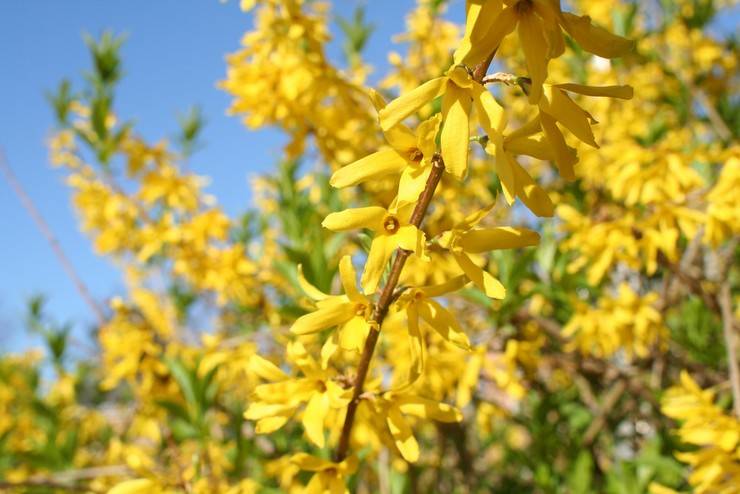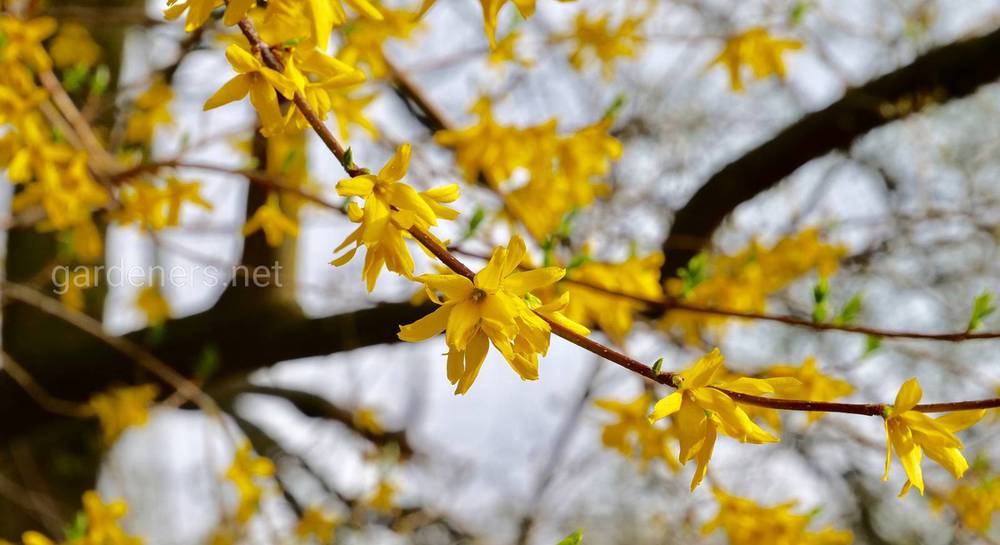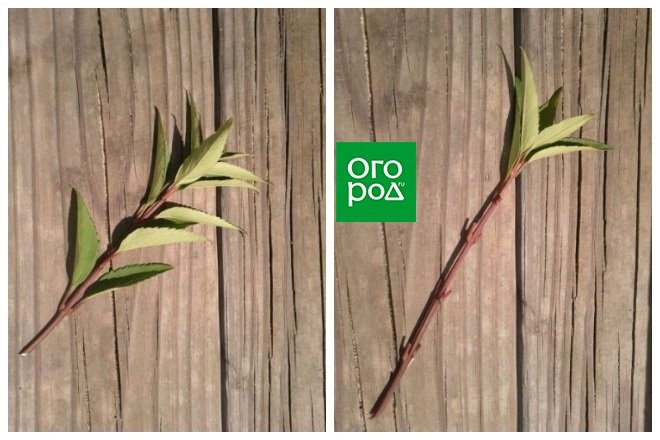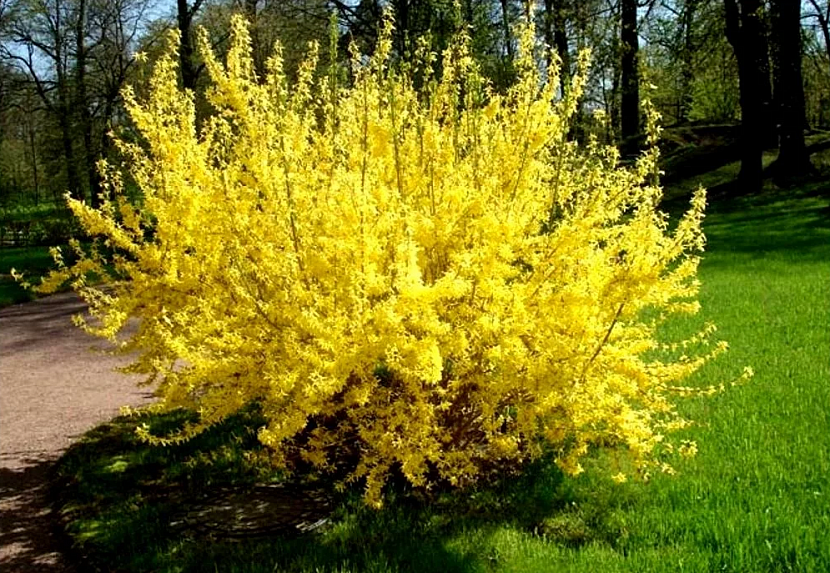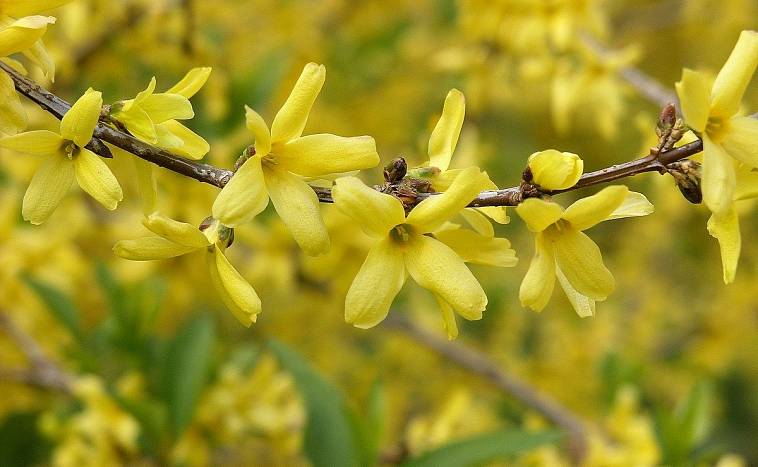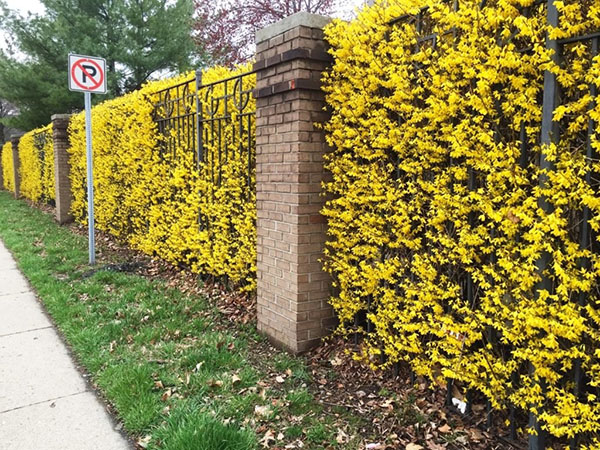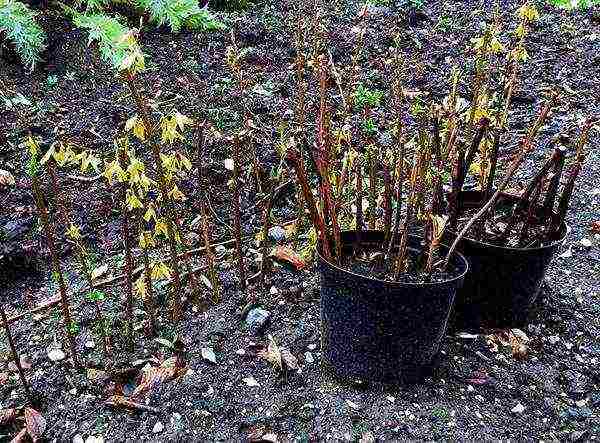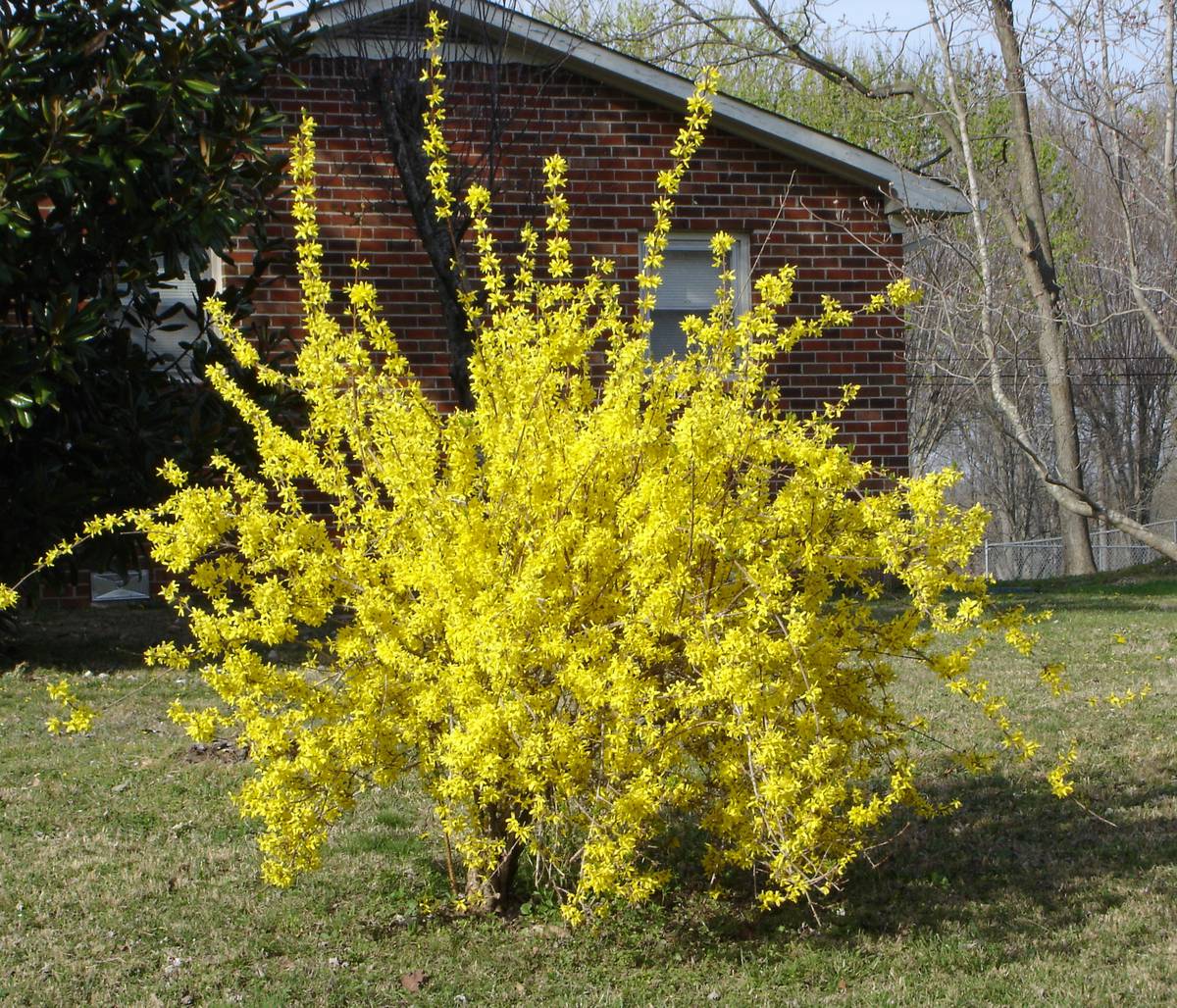How else can this shrub be propagated
Cutting is the most common (and convenient and fast) way of forsythia propagation. But if you are serious about something, you need to know as much as possible about your hobby! Therefore, I will tell you about other breeding methods.
Side layering
In the spring, when flowering is over, cut the bush chosen for reproduction at the root. Over time, he will let go of the shoots. In autumn, bend them to the sides, laying them in furrows specially dug in the ground (so that water does not stagnate in the ground, pour fine rubble on the bottom of such trenches, and sprinkle it with soil on top).

The stems must be secured (for example, with pegs). From above you need to pour earth and lightly tamp it.
Over the winter and next spring, roots will sprout in the shoots pinned to the ground. You just have to cut off these branches, and when the resulting bushes get stronger, move them to another place (if necessary).
The second option for such reproduction
It is convenient in that it does not require cutting the bush and does not deprive you of the spring flowering of forsythia.
In late spring or early fall, choose a pair of flexible twigs on the sides. Tilt them into trenches as described above. In order for them to take root for sure, on the side of the branch that lies in the ground, you need to slightly cut off the bark.
The rooted shoot can be replanted in the spring.
Bushes propagated by cuttings bloom in the second year of life.

Division of the bush (root suckers)
When flowering ends, the bush can be dug out (both completely and only part of it). Part of the rhizome is cut off with a sharp secateurs and, together with the bush, is transferred to another place.
Choose a sunny area immediately. But for the first few weeks, shade the little thing. Also, don't forget to water it.
Seeds
This is the longest process. But it is also the most productive, because one flowering twig will make a mass of young bushes.
Everything is done like this:
- Collect the seeds in October (they are fully ripe this month).
- They need to be stratified for 2 months (keep them in a wet scarf, in the refrigerator or just in a cold room, at 3-4 degrees).
- From March to April, they can be sown in deep boxes (preferably with drainage at the bottom). Choose a nutritious and light soil (peat with sand is a good option).
- Keep the box in a homemade greenhouse (under glass or the same bag), spray or lightly spill the soil from time to time. The box should stand in a warm room.
- After a month (or more precisely, from 20 to 40 days), the seeds will germinate. By the way, get ready for the fact that only about a third of all seeds will hatch.
- They should grow in the same box. They will be very reluctant to do this. For a year, the sprouts will rise by only 8 cm, or even less.
- A year later, in the spring, they can already be transferred to a flower bed. Over the summer, future bushes will rise by 2/3 of their height.
- Wrap up young forsythia with foliage (sawdust, straw) for the winter.
- The next year, you can transplant the bushes to a permanent "habitat".
These bushes will not bloom soon - 5, or even 6 years later.
A garden expert will tell you about the advantages of such a bush, as well as about basic care for forsythia in this video:
Propagation of forsythia by cuttings in spring
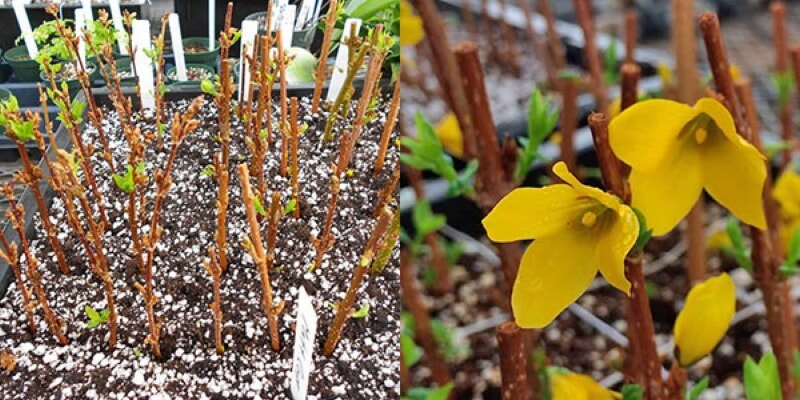
At the end of autumn, all plants are dormant. This is a good time to select the thick, annual branches of the shrub. They must be in good condition, free from damage and unnecessary bends.
Propagation of forsythia by cuttings includes the correct cutting technique:
- length - 15-20 cm;
- the upper cut is made straight, and the lower one - at an angle to increase the area of root formation;
- the distance from the edge to the first knot on both sides is 1-2 cm.
The resulting parts of the plant are sent to a cool cellar or refrigerator for storage until March. Forsythia propagation by cuttings in spring is carried out in 2 ways. Vegetative shoots are planted in containers with nutrient soil or directly on a flower bed. Before this, the slices are updated. Fertile soil from the garden is taken as a soil substrate. It is mixed with perlite or sand.
Agricultural technology for planting in greenhouses:
- embedment depth 4-5 cm;
- the distance between the seedlings is 5-7 cm;
- shelter in the form of a plastic cover, glass.
For successful rooting, the cuttings are immersed in a Heteroauxin or Kornevin solution. After 3-4 hours of infusion (sometimes 8-10 hours), they are planted in the ground.
Extraordinary seedlings are watered regularly to keep the topsoil always moist. The greenhouse is ventilated daily for 15-20 minutes. With this cuttings forsythia in the spring (in April / May), the rooted seedlings are transferred to a permanent place in the garden. However, experienced growers leave the plant in a pot for another 1 year so that it grows a strong root system. Then the shrub will take root perfectly in the front garden and will start growing faster.
Planting forsythia cuttings in open ground

For planting prepared shoots, choose relatively warm, but not hot weather. As already noted, cuts are made again in the upper and lower parts. The bed is dug up, forming grooves up to 10 cm deep.An interval of 5-7 cm is maintained between individual specimens.
Up to 2-3 buds are left above the ground. The near-bore area is slightly tamped. The planting must be watered.

Since it is quite easy to propagate forsythia by cuttings in the spring, many do not take this event seriously. However, the young plant must continue to be taken care of, especially during the winter. At the onset of the first frost, the plantation is covered with spruce branches or fallen leaves.
Reproduction of forsythia by cuttings in water in spring is carried out quite rarely. In most cases, such specimens turn out to be weak and, as a result, die.
When the heat comes in, the protective structure is removed. Further, the sprouts are closely monitored. They are watered so that the rhizome is constantly in a humid environment. However, the area should not be excessively wet. Otherwise, the shrub will not be able to breathe and will start to rot. If the technology of forsythia cuttings is followed correctly, then in a month the first leaves will appear on the trunk.
Propagation by seeds and layering
So how to propagate forsythia? It is well accepted when grown in green and lignified cuttings. Two more methods are less popular - this is reproduction by layering, as well as by seeds. The latter, by the way, is very laborious, but with the help of seeds, healthy forsythia can be grown in large quantities. But this is a very long time, the cycle from planting seeds to flowering can stretch for a very long time.
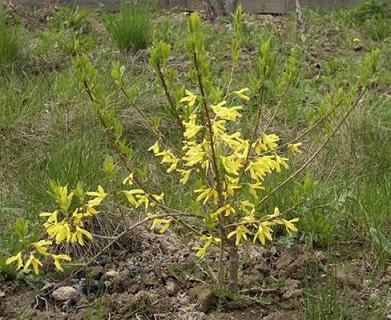
Reproduction of forsythia in spring by layering begins with the fact that the shoots on the mother plant must be cut under a stump so that healthy young branches can grow over the summer. Already in the fall, they will need to be bent to the ground and placed in shallow grooves. For reliability, it is better to pin the escape with a piece of wire, and only then cover it with earth. The soil before such a "planting" also needs preliminary processing. Firstly, it must be well loosened, and secondly, at the bottom of the grooves it is better to arrange a drainage layer of fine gravel crushed stone. From above it should be sprinkled with soil.
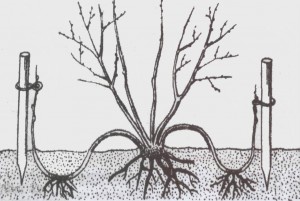
It is allowed to propagate by layering not only in autumn, but also in early spring, but the shoots must be young.
Pruning forsythia
Pruning is perhaps one of the most important elements of forsythia care. The splendor of flowering, and the appearance of the bush, and the duration of its life depend on this.
Pruning methods
Mandatory pruning is done in the spring and fall.After flowering, all old or dry branches are cut out, the rest are shortened by about half. In the spring, the frozen parts of the branches are necessarily cut off. If you cut off individual aged branches, leaving 4-6 centimeters from the ground, fresh shoots will go from them.
Anti-aging pruning can be done in the same way. Then all the branches are cut almost to the ground - no more than 6-10 centimeters are left. But such pruning can be done no more often than once every 4-5 years.
Pruning can be done during the summer in order to give the bush a certain shape or in order to thin out its density a little. If this is not done, then it will be much more difficult to wade through the jungle of overgrown branches, and the quality of flowering may suffer, since old branches bloom poorly and reluctantly.
Important! Pruning is done only for mature plants. Very young bushes are allowed to grow and branch first.
Pruning in the fall
Autumn pruning is also carried out to remove old branches, but it is not decisive for the growth and flowering of the plant.
Types of forsythia
At the moment, the classification of forsythia includes six main types and a great many varieties that it makes no sense to list within the framework of this article. In the table below, we will focus on the key characteristics of each species and how they differ from each other.
Table 1. Types of forsythia
| View | Description |
|---|---|
|
Forsythia hanging motley |
Forsythia of this species are distinguished by their two-colored bright leaves - green in the middle and yellow at the edges. The xiphoid shape of the motley forsythia leaves is combined with characteristic serrations. During flowering, the shrub is covered with rich yellow flowers. |
|
Forsythia dangling Fortune |
Fortune's Forsythia tends to change its shape over time. In the first couple of years, its branches are erect, however, as it "matures", this shrub acquires curved shoots, which are a real hallmark of this species |
|
Hybrid forsythia |
Hybrid forsythia was bred as a result of many years of work of breeders, as a result of which it became even more hardy and frost-resistant compared to other species. Such forsythia grow up to three and a half meters and delight gardeners with annual lush flowering. On shrubs, both simple oval leaves and trifoliate can come across |
|
Forsythia ovoid |
This type of forsythia overtakes all others in terms of flowering speed. Unfortunately, it is not possible to admire the beautiful flowers for long - after two and a half weeks they have already fallen off. However, even after flowering, the shrub retains its beautiful appearance due to the yellow and deep purple leaves. The average height of the bush is two meters |
|
European forsythia |
An adult forsythia, during flowering, resembles a beautiful crescent, thanks to two-meter branches dotted with bright lemon-colored bell-shaped flowers. The leaves of the plant have a pleasant pale green color. This type of forsythia is distinguished by its vitality - with proper care, such a bush can last for seventy years. |
|
Forsythia dark green |
The name of this type of forsythia is directly related to the deep emerald shade of the foliage. Dark green forsythia blooms in bunches, in which three flowers are concentrated. Unlike other species, the dark green fossil is more demanding on temperature conditions and takes root better in the southern regions of Russia with a mild climate. |
In Russian conditions, gardeners prefer the following types:
- hanging;
- ovoid;
- hybrid.
Caring for forsythia in the garden
How to care for forsythia
Planting forsythia and leaving in open field behind this shrub simple and not burdensome. A mandatory point of care is only watering and pruning the plant, and feeding and treatment from diseases and pests is carried out as needed.
Watering forsythia
In the season with normal rainfall, forsythia can not be watered, but if dry and hot weather sets in for a long time, then at least once or twice a month pour a bucket of cold water under each bush, and when it is absorbed, loosen the soil around adult bushes to a depth shovel bayonet and remove the weeds. In general, it is best to keep the forsythia stems under a layer of mulch made from dry soil, compost, or other organic material.
Feeding forsythia
During the season, forsythia growing on poor soils is fertilized three times: in early spring, rotted manure is spread in a thick layer along the near-trunk circle away from the trunk and branches, after which the soil is watered abundantly; in April, the soil around the bush is watered with full mineral fertilizer at the rate of 60-70 g / m²; when the forsythia fades and begins to lay buds for the next season, a solution of Kemira-universal is introduced into the soil at the rate of 100-120 g / m².
Pruning forsythia
Forsythia is pruned in spring for sanitary purposes: broken, frozen and dry shoots are removed. This cleaning will be enough for young bushes, but for adult plants, the main one is summer pruning, which is carried out after flowering is completed: the faded shoots are cut half the length, and the old and dried ones - at a height of 5-7 cm from the surface of the site, after which they will give new lateral shoots. In adult plants, pruning also regulates the density, height and shape of the bush, which is usually spherical or cupped. The aged bush is rejuvenated by cutting off all the shoots by 2/3 of the length, but you should not abuse radical pruning, because after it the bush will grow, but it may stop blooming. So that forsythia does not lose its attractiveness and blooms profusely, the rejuvenation of the bush is carried out no more than once every 4-5 years.
Reproduction of forsythia
The easiest way to propagate forsythia vegetatively is by cuttings. In June, green cuttings 15 cm long are cut from the bush, the lower leaves are removed from them, the cut is treated with a root former (Epin, Kornevin or Heteroauxin) and planted in a cuttings with sand or perlite. Lignified cuttings are cut in October and planted for rooting right in the garden, leaving 2-3 nodes above the surface and reliably covering the seedlings for the winter with dry leaves or spruce branches. In the spring, the shelter is removed, and by the next fall, the seedlings are dug up and planted in a permanent place. The forsythia stalk blooms in a year.
Forsythia is easily propagated by layering. To do this, in summer or autumn, low-growing shoots are bent to the ground, pulling it at the base with a soft wire and making an incision on the side that comes into contact with the soil. The shoot is fixed and covered with soil. Separate it from the bush next spring, and after a year, the cuttings will bloom.
As you can see, there are several fairly simple ways to propagate forsythia, so there is no point in growing this plant from seed.
Forsythia after flowering
After the end of flowering, forsythia is cut off, and it will retain its decorative effect until autumn. In winter, forsythia in the Moscow region and other regions with a temperate climate needs protection from low temperatures. Before the onset of cold weather, the near-stem circle of the plant is covered with a layer of dry foliage 10 cm thick, and the branches are bent to the ground, fixed in this position with hairpins and spruce branches are thrown on top. In early spring, the shelter is removed so that the flower buds do not spill out.
In the southern area, it is enough to insulate the forsythia trunk circle for the winter.
Reproduction methods
Forsythia reproduces vegetatively and by seeds, which ripen in capsules in October. Vegetative propagation is carried out by layering and cuttings (green spring, lignified summer and winter).
Photo: Forsythia
Seeds
If a large number of plants are required, then the most productive method of propagation is seed. Ripe seeds are harvested in October and placed for 2 months indoors (+ 2- + 5 * C) to undergo stratification.In the spring in March-April, seeds are sown in a greenhouse or boxes with light nutritious soil. To maintain a constant temperature and soil moisture, sowing in boxes is covered with foil or glass. Seedlings are received in 20-40 days. Germination rate is low, within 30-40%. Seedlings grow slowly and reach only 2-8 cm in height in the first year. In open ground, on previously prepared ridges, they are dived next spring. During the summer of the second year of life, the seedlings grow up to 12-30 cm by autumn and require warming for the winter (especially in cold regions) with a layer of leaves, coniferous paws, and other covering material. In the third year, young plants reach 70-90 cm and can be used for planned plantings. Seed-propagated forsythia plants bloom for the first time after 5-6 years.
Layers
Forsythia propagation by layering is the most affordable and easy. Forsythia has the ability to root itself when the branches come into contact with the soil. In order not to violate the decorative effect of the bush, rooted shoots are forcibly obtained from the mother plant. To do this, in spring, in the second half of summer or in autumn, young flexible branches growing at the base of the bush are noted. From the base of the branch, dig a groove 2/3 long of the marked shoot and a depth of about 10 cm. Tear off the leaves at the last, leaving them only at the top, which will not be covered with soil. To speed up the rooting process, an incision is made in the bark on a branch. Bend the shoot to the ground, pinning it in 2-3 places with a V-shaped strut from a dry branch or wire and cover it with soil. The soil above the sprinkled shoot should be moist (do not flood with water). By the spring, a rooted shoot will be formed, which is separated from an adult bush and planted permanently. Bushes propagated by layering bloom after a year.
Photo: Forsythia
Cuttings
This type of reproduction is more often used in the middle lane with blanks of 3 types of cuttings:
- green,
- summer woody,
- autumn woody.
For propagation by green cuttings, vegetative shoots with 7-10 cm internodes are chosen in June. Cuttings are cut into lengths of 1-2 internodes. From the bottom and top of the cutting, stumps are left 1-2 cm long from the node. The upper cut is oblique, the lower one is straight. The lower leaves are removed. Cut cuttings for 3-4 hours are dipped with the lower end into a container with a solution of root or heteroauxin and planted in boxes with sand or on a garden bed in a greenhouse at a distance of 5-7 cm to a depth of 4-5 cm.The soil is kept constantly moist by pouring into a hot dry time at small rates 3-4 times a day. After a month, almost all cuttings form roots. For the winter they are left unchanged, they are insulated only if necessary. The next spring, they are transplanted into open ground and for 3 years permanently. Rooted shoots bloom in the same year.
Reproduction by lignified cuttings (summer and winter) differs from spring only in the time of harvesting the cuttings. This breeding method is more suitable for the southern regions. In the second half of summer or at the beginning of autumn, cuttings 15-18 cm long and 1.0-1.5 cm thick are harvested. A ridge is prepared and cuttings are planted to a depth of 7-10 cm. 1-3 buds remain above the ground. The planted cuttings are watered. At the onset of cold weather, they are insulated with fallen leaves, spruce branches and snow on top without trampling.
Thus, forsythia as an ornamental plant can be used for decoration in the form of specimen plantings on lawns or in perennial mixborders, as a hedge. Forsythia is propagated by seeds and vegetatively (by layering and cuttings).
Reproduction
The plant propagates quite simply - by layering, cuttings, and less often by seeds.
Layers
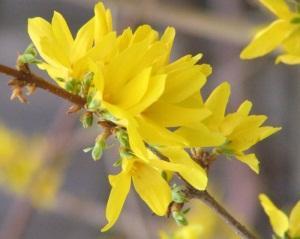 This method is most often used because of its simplicity.
This method is most often used because of its simplicity.
If forsythia branches bend to the ground
, and they will come into contact with it for a long time, then they will soon take root themselves.
But it is better to monitor the reproduction yourself and choose the best branch, bending it to the ground and digging it in.
It is necessary to cut the bark in the place where the branch is dug. In the spring, when the shoot takes root, it can be transplanted from the main bush to another location.
In a year, the young forsythia will already bloom.
Cuttings
This method is also quite simple. Can multiply lignified and young shoots
... Young green cuttings are cut in early summer.
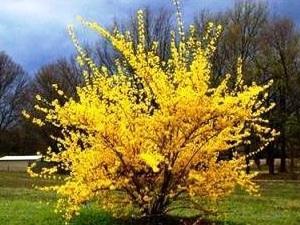 To begin with, they are kept in a solution from the root for some time, they are planted with a priest in specially prepared soil and covered with a film so that create greenhouse conditions
To begin with, they are kept in a solution from the root for some time, they are planted with a priest in specially prepared soil and covered with a film so that create greenhouse conditions
.
Already in the fall, the cutting will take root and take root well.
At this time, it can be assigned to a permanent place and covered with a ball of dry foliage for the winter.
Lignified cuttings are cut for planting in the fall. Their length should be up to 18 cm. They are planted in the ground 10 cm deep. Several buds are left on the surface. In order for the plant to overwinter, it is covered with dry leaves.
Seeds
This method is rarely used. The percentage of seed germination in the region of 40%. Their sown in boxes with soil in spring
... The first shoots appear in a month.
For a year, young shoots grow up to 6 cm. In the second year they can grow up to 30 cm, they can already be planted in open ground and left to winter under a thick layer of leaves.
The first flowering of such a shrub occurs in the 4-6th year of life.
Forsythia is a good option for gardeners and summer residents. With this shrub, you can create a vibrant colorful fence. In addition, having given it the desired decorative shape, you can organically fit it into the landscape design of any site.
Care
In early spring, before flowering shrubs you need to feed
mineral fertilizers - 1m 2 70 grams.
When the plant has bloomed and the next flower buds will be laid, you can use the kemiru wagon (100 grams per m²).
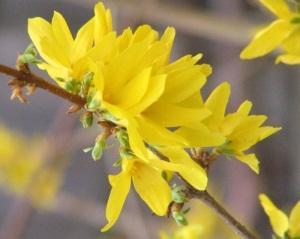 If there is enough rainfall, then additional watering for the forsythia is not necessary.
If there is enough rainfall, then additional watering for the forsythia is not necessary.
It is better adapted to dry weather than excess moisture.
But still, if in summer there is a long sultry weather without rain, then once a month the shrubs must be watered with 10 liters of water under each.
After watering, the soil around the flower is loosened and compost is added.
It should be carried out regularly weeding forsythia
... When weeding, it is necessary to loosen the soil with one shovel bayonet. This allows air to freely penetrate to the roots and nourish them.
At the beginning of spring, it will be beneficial for the plant mulching the land around
manure, which will at the same time be a top dressing.
The plant is very resistant to pests and diseases
... When wilting, it is sprayed with zineb or foundation.
If nematodes are found, then the soil around the forsythia is disinfected with carbation. With bacteriosis, the shrub is uprooted and removed.
Follow-up care after transplant
It is not enough to know how to root forsythia with cuttings to obtain an attractive shrub for decorating a garden.
It is also important to observe proper care after transplanting to a permanent location of the plant.
Preparing the soil for transplanting a seedling
A yellow shrub in the spring requires a properly selected soil. The culture does not tolerate acidic and heavy soil. It is also necessary to avoid places with a closely located water table. Before planting a seedling, you need to mix the soil from the planting pit with humus and sand in a 1: 1: 2 ratio.
Additional Information! Before planting, a drain is placed in the pit. For this, large crushed stone is used.
Watering
Moisture is essential for the development of the shrub. Water the seedling as the soil dries. After the seedling gets stronger, the frequency of watering is reduced to 1 time in 2 weeks.

Seedling care
Fertilization
In order for the flowering of the culture to be exuberant, fertilizers must be applied. In the first year after planting, top dressing is not used. In the second year in the spring, after awakening the buds, nitrogen fertilizers should be used.To increase the color, potassium-phosphorus fertilizers are used, which stimulate the formation of buds. After the bush stops blooming, fertilizing is reduced. Complex fertilizers can be used in summer. At the end of summer, organic fertilizers are used.
Pruning bushes and sheltering for the winter
Autumn is the period when you need to prepare the culture for the first frost. A few weeks before frost, you need to cut the bush. All branches are shortened, and damage to the crop is removed.
The bush must be carefully tied with twine and bent in the ground. The root is covered with a mixture of humus and foliage
Branches - fallen leaves or agrofibre.
Autumn harvesting of cuttings
Interesting! In the spring it is necessary to open the bush. Otherwise, mold may develop on the bark.
Forsythia is a spring shrub that will decorate any garden. Propagated by cuttings, seeds and cuttings. The last method is the most common, as you can get the required number of seedlings. Reproduction of culture by cuttings in the summer allows you to plant young shoots in open ground. Experienced gardeners recommend seedlings for seedlings from 1 year old.
When to trim
Regular removal of non-viable and excess sections is required due to the fact that the bush is a fast-growing one. Its dimensions reach 2 m in width and 3 in height, but it is too large for growing in the garden. Therefore, the diameter is reduced to 1.5 m.
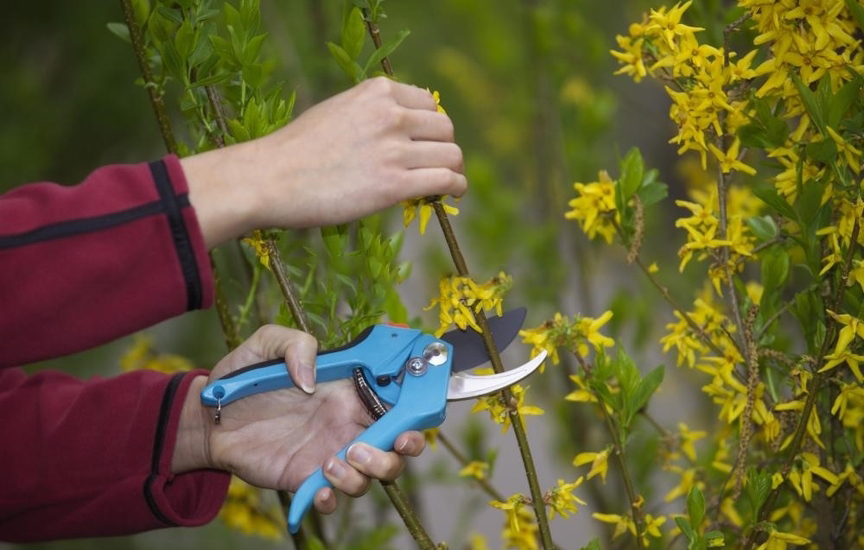
The appearance of the forsythia bush
You need to know the timing of when to cut the forsythia, so as not to harm the plant. The first 3-4 years, active pruning of the bushes is not required. The plant must be given the opportunity to grow and get stronger. Then the solution of the problem when to cut forsythia is carried out in 2-3 stages. The pruning scheme involves 3 types of haircuts: first, regular and rejuvenating. They differ in the regularity and amount of material removed.
For the first time, pruning is carried out in March-April, even before the foliage appears, in the second year after planting. It is easy to visually identify dry and damaged parts, active sap flow has not yet begun. The first shearing of forsythia implies almost complete removal of shoots, leaving a few of the strongest ones.
The main correction is carried out in the spring, after flowering. In the summer, the bush will have time to recuperate. Additionally, the procedure can be carried out in the fall, but this pruning does not determine the intensity of growth and flowering of the bush for the next year.
Attention! Correction of the bush is possible during flowering only when the plant is sick, it is neglected or has many damaged shoots. During the active period, the bush is most vulnerable, therefore, the harm from pruning should be compared with the harm from damage
If you can wait until the end of the period, then you should refrain.

Stages of forsythia bush formation
By standard, the next step is pruning the forsythia after flowering. Do not cut off many shoots at once, this will negatively affect the condition of the bush. Therefore, care is required throughout the year.
Landing
Pits for planting this plant are prepared in advance. They are filled with the following composition: 1 part of humus, 1 part of sheet soil and 2 parts of sand.
If the acidity of the land on the site is increased, neutralized lime or chalk solution (300 - 400 g) or wood ash is added to each hole for planting (200 g).
Drainage is made of crushed stone and crushed bricks, the layer of which should be 15-20 cm. A layer of sand 6-8 cm is poured on top.
The distance between each plant should be 1.5 - 2 meters, the depth of the hole is 50 - 70 cm. Its parameters are 60x60 or 70x50 cm. It is better to plant forsythia in the fall, before frosts come.
When choosing a place, it should be borne in mind that the plant will bloom in a few years up to 3m in height and 2m in width.
Freshly planted shrubs are watered abundantly and a layer of mulch is laid (peat, humus, rotted foliage), the branches are tilted to the ground, fixed with wire and make a shelter for the plant so that it can overwinter and not freeze.
Moreover, you need to cover all types of forsythia. For these purposes, materials are used through which air penetrates. This is necessary so that the shoots and buds do not vomit during the thaw.
You can cover the bush with needles. In the spring, the material is removed from the plant, the branches are straightened, and the flooring from the leaves is removed.
Although you can plant a shrub in the spring. When buying seedlings, it is advisable to choose them with a closed rhizome. In this case, they will take root better.
Ideal drop-off location
will be where there is a lot of sunshine. But also the plant should be away from drafts and wind.
But a slight partial shade will not harm the plant either. Many flower lovers prefer to plant forsythia in the country because of its unpretentiousness to watering. This is important if it is not always possible to water it in a timely manner.
Planting forsythia outdoors
In order for the cultivation of a shrub to be successful, certain rules for planting it must be followed. Next, we will consider the main stages of this process, so that it would be easier for you to choose a site for a shrub in your garden, and direct planting in the ground did not require much time and effort.
Choosing a place and time for landing
Forsythia is very sensitive to sunlight, so you should choose well-lit areas for growing it. If your garden does not have such areas, you can plant a shrub in partial shade. Under these conditions, forsythia will also develop, but the flowering will be less lush and lasting, although in general the decorativeness of the culture will remain.
Despite the good illumination, it is desirable that the site be protected from strong winds and drafts. The branches of the plant are large enough, and the flowers appear early, so sharp gusts of spring wind can easily break them off.
What soil is suitable for planting
The best soil for a plant is a mixture of sand, humus and leafy soil in a ratio of 2: 1: 1. It should also be borne in mind that calcareous soils are much more suitable for a plant than heavy and waterlogged ones: in such areas, the seedling simply will not take root.
Before planting in the holes, it is advisable to place a handful of slaked lime and wood ash. You should also take care of removing excess moisture from the site by arranging drainage, without which the roots of the bush can begin to rot and the plant will die
How to plant seedlings
Unlike other crops, forsythia is best planted in early fall, although spring planting is fine in some cases (unless the summer is too hot in your area). The procedure for planting shrubs is shown in Figure 3.
Planting forsythia seedlings is carried out as follows:
- On a site selected and previously cleared of weeds, holes are dug 60x60 cm in size. If you are planting several seedlings at once, make sure that the distance between them is at least 2-3 meters;
- A drainage layer is laid at the bottom of each hole and 200 grams of wood ash and slaked lime are poured;
- The seedling is immersed in the hole, deepening by 70-80 cm;
- Each hole is covered by a quarter with any drainage material (broken brick, expanded clay, etc.) and the rest of the hole is filled with fertile soil.
 Figure 3. The main stages of planting seedlings
Figure 3. The main stages of planting seedlings
At the final stage of planting, the soil around the seedling is compacted and watered abundantly.
Care features
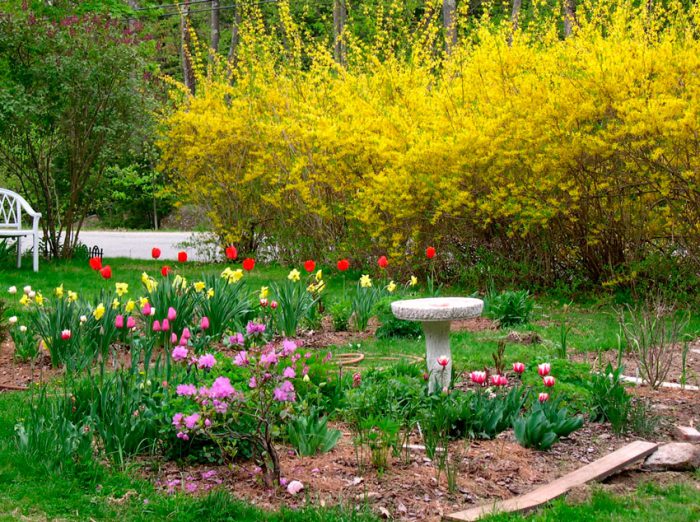
It is necessary to care for forsythia in the same way as for other shrubs grown in the garden. If it rains regularly in summer, then you will not have to water this plant. This should be done only with prolonged drought 1 or 2 times in 4 weeks, while 10 to 12 liters of water are taken for 1 bush. After the plant is watered, weed and loosen the soil to the depth of the shovel bayonet, this is the only way to ensure normal air access to the root system. When loosening is finished, sprinkle the trunk circle with a layer of mulch (dry soil or compost).
Forsythia should be fed 3 times during the season. For the first time, you need to feed the plant at the beginning of the spring period. To do this, a sufficiently thick layer of manure (necessarily rotted) is laid out on the surface of the trunk circle, make sure that it does not touch the branches or the trunk. Then it is watered with plenty of water.Manure will become not only organic fertilizer for the plant, but also mulch. Complete mineral fertilizer (per 1 square meter from 60 to 70 grams) should be applied to the soil in April. When the plant blooms and the laying of flower buds for next year begins, it will need to be fed with Kemira-universal (for 1 square meter from 100 to 120 grams).
Reproduction of forsythia
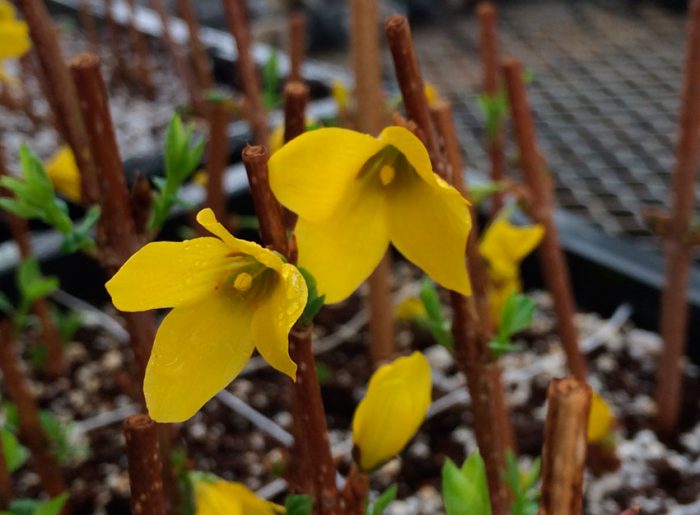
For reproduction, vegetative methods are most often chosen. For example, cuttings. Harvesting green cuttings should be carried out in June, while their length should be approximately 15 centimeters. At the cutting it is necessary to cut off the leaf plates located below, then it must be treated with a drug that stimulates the growth of roots (Epin, Kornevin or Heteroauxin). It is planted in a greenhouse using sand or perlite. Lignified cuttings, which are harvested in October, are also suitable for reproduction, for rooting they are planted directly in open soil, while 2 or 3 buds should remain above its surface. Do not forget to cover the cuttings with fallen leaves for the winter. In the springtime, it is necessary to remove the shelter, after which the cuttings will begin to grow actively, and in the fall they will already become full-fledged seedlings. For reproduction, you can use layering. In order to get them, you need to choose a stem growing very close to the surface of the site in summer or autumn. At the base, it is pulled over with wire, and an incision should be made in the bark on the surface that faces the ground. The stem is fixed on the soil surface and covered with nutritious soil. Layers take root in a relatively short period of time. In springtime, it is necessary to separate the cuttings from the parent plant, and after only 12 months it will begin to bloom.
It is possible to grow forsythia from seeds, but only specialists resort to this method of reproduction.
FORZITION. How to propagate by cuttings - 7 summer cottages
Pruning forsythia
Young bushes need only sanitary pruning, during which all dried, injured, and frost-damaged stems are removed. If the forsythia is adult, then in spring only the frozen tips of the branches are cut off from it. The main haircut is done in the summer, when the bush has faded. Those branches that have faded should be cut off by ½ part, while dried and old ones should be cut at a height of 40 to 60 mm from the soil surface, in this case young side shoots will go from them. With the help of pruning, you can control the height, density and shape of the crown, which can be spherical or cupped. In the event that the old bush needs rejuvenating pruning, then all its branches must be cut to a height of 4 to 6 centimeters or shortened by 2/3, thanks to this, young shoots will begin to actively grow. However, very often it is impossible to carry out anti-aging pruning, because from this forsythia it grows very much, but the flowering stops completely. As a rule, a rejuvenating haircut is recommended once every 3 or 4 years.
Diseases and pests

This plant is highly resistant to diseases and pests. In rare cases, the bush can be affected by moniliosis, wilting or bacteriosis. A bush infected with wilting should be treated with a foundationol solution (2–5%). If forsythia is struck by bacteriosis, then in this case it will have to be dug up and burned. If brown spots have formed on the surface of the leaf plates, this means that the plant is sick with moniliosis. In this case, it is recommended that all affected parts of the plant be cut out and thoroughly cleaned to healthy tissue. Also, the bush can suffer from nematodes, in this case, the soil is disinfected with Carbation.

